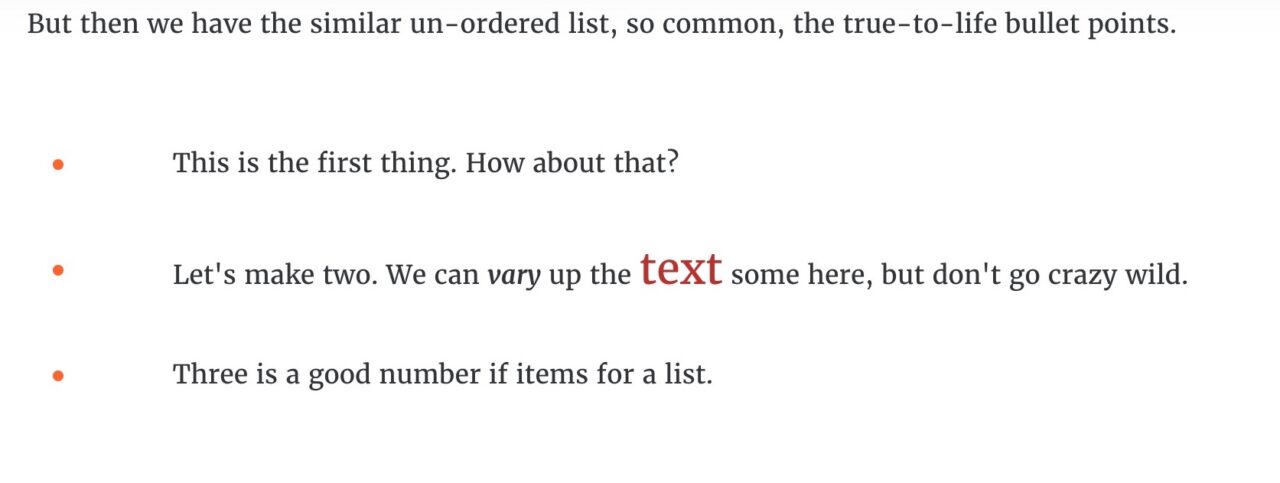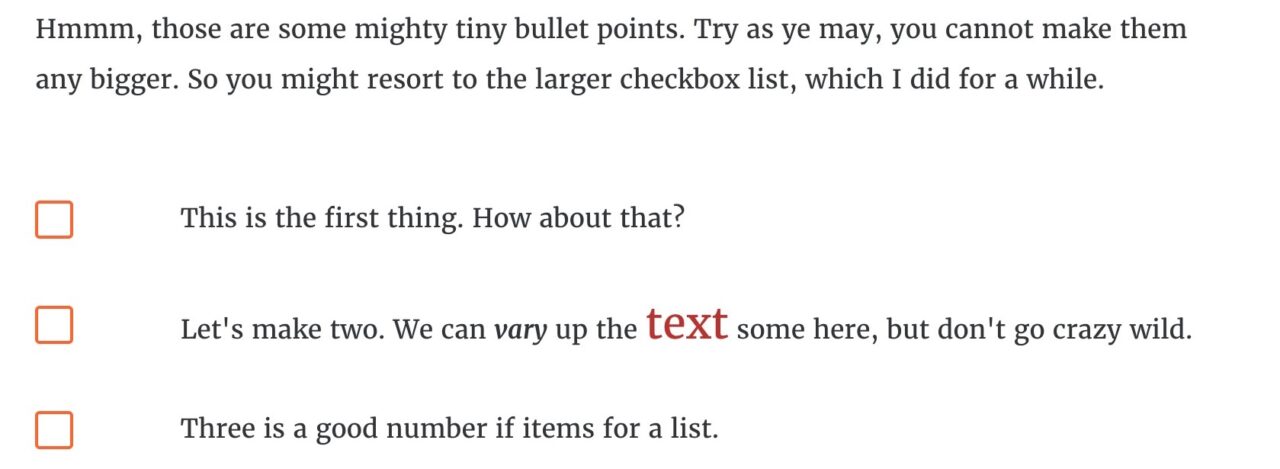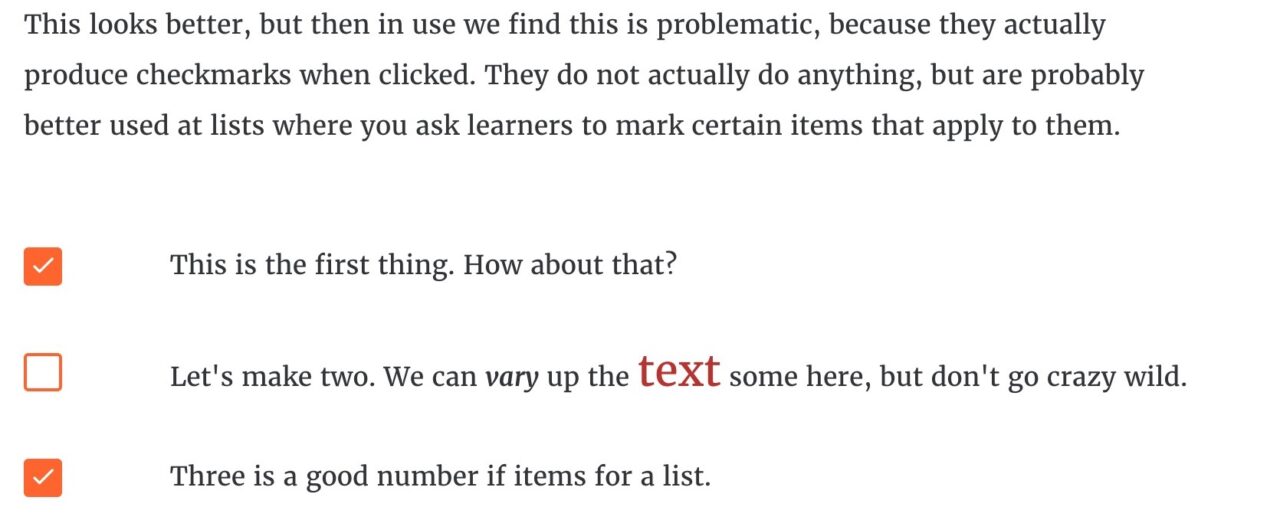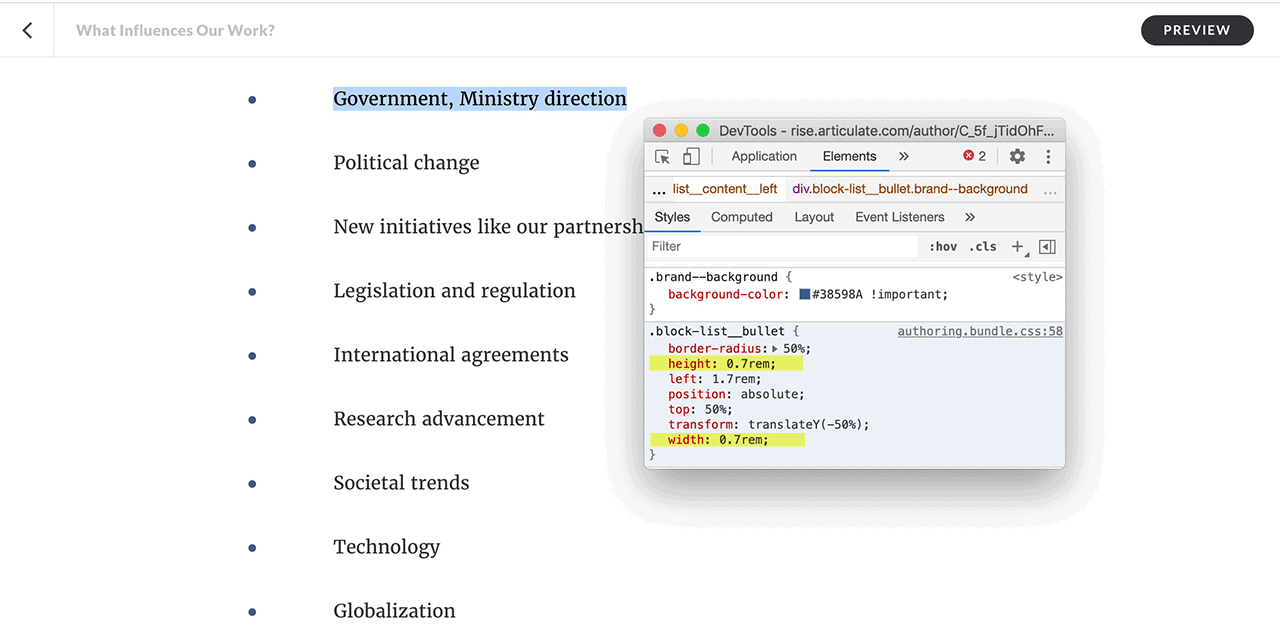… then you just might have to pound them in yourself.
And few things in this tech work give me more joy when figuring an end around, even if it’s one you end up not using.
Rising
For a number of months, I’ve been working away on an [unblogged about] project for JIBC, again like last year’s work on a leadership resource site, is something for BC Corrections. Without going into too much (yet) let me just say this is putting online a ton of materials (14 hours of learning to prepare for in follow up in-person training) aimed at all current staff as well as new ones as they come on board.
The content is delivered in, yes Blackboard, but my role has been in turning pages of content that come at me in Word files, to something interesting (I hope) that we publish in Articulate Rise 360. I had never used it before, but it’s not terribly complex. And the authoring is all done via a web browser.
What it produces is clean and works elegantly in different device sizes. It provides variety of content “blocks” – for text (basic, headings, large text statements, lists, a few quotation), media (embeds video, audio, iframe code), images (full screen, centered, left/right aligned, text atop, carousels), interaction (tabbed, accordion, flip cards, sort cards), very simple assessment (multiple choice, fill in blank), even a simple branching scenarios. Yes, it’s aimed squarely at corporate type training.
The tradeoff, though, are a lot of limits to what you can do and very limited customization. The irony is that it’s all published as web content, but you cannot do everything you can possibly do in a web page.
A lot of my work here has been apologizing- telling my content writers “nope, we can’t do that” or “sorry I can’t change the format like that” but also in coming up with ways to pull of their ideas in this limited set of tools.
All of those leads me to bring the tale of bullet points.
3 Are the Types of Bullet Points, No More, No Less
As it does, Rise offers three, no-more-no less ways to create lists. Three shall be the number of styles thou shalt count– oh excuse me, Monty Python moment. First, since we are counting, are your web style ordered lists (ignore the late night typo in bullet 3, sad):

Yup, a pretty version of what you get in HTML with <ul&/gt; tags.
Not making an enumerated, list? Reach for the bulleted list type. Or what in HTML is an un-ordered list.

Yeah, bullet points. They seem like very tiny bullets, right? So in the development, I started reaching for the 3rd type, checkbox lists, since the marker was bigger.

It’s maybe better visually, but here I made the mistake of reaching for a visual change that introduced a problematic confusion with function. Because in Rise, these kinds of lists the boxes can be “checked” by a learner when clicking them. The check provides no response/feedback; it seems to be more useful when you want to provide a list of things with a prompt and a reason to check the items.

So it’s not ideal from a functional standpoint, and can lead to some confusion as to why a list of items can be checked off.
Can We Change…. No.
My content folks asked a few times- “Can we make the bullet points bigger? Can we use a different symbol for lists? Can we use this picture icons for lists?” I feel rather rigid in having to say “no” all the time. But they did provide feedback that the check box style was confusing, so I needed to do something.
I did my searching and looking for possible answers in the Rise user forums (which has the fun title of “E-Learning Heroes”).
I found discussions of it in a thread that was 3 years old that started with a request (and upvoted pages and pages of times) to allow coloring of text bullets. And actually they were discussing bulleted lists inside the text editor. But it’s in the same vein- they things people here are asking for are just CSS changes, ones not afforded access to in a visual editor.
The company responses are repeated pastes of:
The text editor used in Rise 360 doesn’t support formatting the bullet or numbering color. We have requested improvements in that tool so you can have better control over bullets. If we get new information, we’ll share it with you here.
Sometimes the responses make it sound like its a technically complex request to make, something that takes years to implement (?).
Since I can preview the content I am developing in a web browser, I just popped an example into my browser, opened up the inspector, and found it was quite easy to change the bullet size for the tiny unordered list. It’s just changing the height and width of the .block-list__bullet class from 0.7rem to something bigger.

But because the Rise Content is delivered via Blackboard (exported as a SCORM package and launched in its own window inside the LMS) I have no means to add custom CSS.
Well, I do. I had an idea. the SCORM package is just a .zip file, and inside is all kinds of typical web content. And by digging around it’s directories, inside scormcontent -> lib I found the content CSS as main.bundle.css.

It’s like 360k of minimized CSS, but a search for .block-bullet__list got me to the place an edit would be needed.

I bumped the value of height and with to 2.5rem, saved, and recompressed the SCORM zip archive.
How to test? That’s easy, I have had to check a few things in the packaging of SCORM using the free SCORM Cloud test site https://cloud.scorm.com/ And voila, a wee bit of CSS tweaking, and we get what is years in the making– bigger bullet points.

This is a proof of concept. In practice, it means that when changes are made to the Rise content (and in each of the 11 existing Rise modules), before being moved to Blackboard, they would need to be run through this process.
It certainly is possible to script a command line process to do this. It’s extra tedious steps, but not as impossible as the Heroes make it out to be.
It’s Really Not About the Bullet Points
This is a lot of blather about a trivial design aspect that I bet most would never take much notice to.
No, I am taking the time to write this (a) to remember, but more (b) to say this is how I relate to web technology. I like to dig around and poke underneath. All of what is wrapped up in this software is dressing on the wide open protocols of the web. And if you can do it with the latter, there’s likely some means to backdoor it into the former.
That’s my point. Don’t stop completely at something they say is not possible until you’ve poked around a bit.
Featured Image: Clay tablets from 1450 BC a Wikipedia Commons image NAMA Linear B tablet of Pylos originally shared under a Creative Commons CC-BY license modified by me by cropping and adding a few bullet points (not well rendered, but hey, it’s a metaphor).



Alan, thanks for the write up this sums up some of the limitations of RISE really well. We’ve been using it for a few years now and encountered some of the same limitations you mentioned here. For one program in particular, we created a styleguide to help keep some consistency across the courses. In particular there are four colours that we use for particular things, and so we ended up using one of those colours for the “accent” set in the settings which then made those 3 types of bullet point block types that accent colour. That also coloured links and a few other things, and then we use the colour feature in the RCE but that can be pretty janky at times.
Anyway, what I wanted to mention was that we also ended up having to dig into those export files. A number of courses were pretty math heavy and our SMEs wanted to write math annotation. RISE chokes on that task, and doesn’t normally come with a way to use LaTeX to create math notation (that’s another win for H5P!) so we went into the js file in the package and added the Mathjax library. Poof, all the LaTeX we wrote in the RISE content editor now renders properly.
Generally I’ve found RISE helps some folks get off the ground quickly with online authoring, much simpler than any LMS, but they hit the ceiling pretty quick. Your team is super lucky to have you on board to take RISE to the next level.